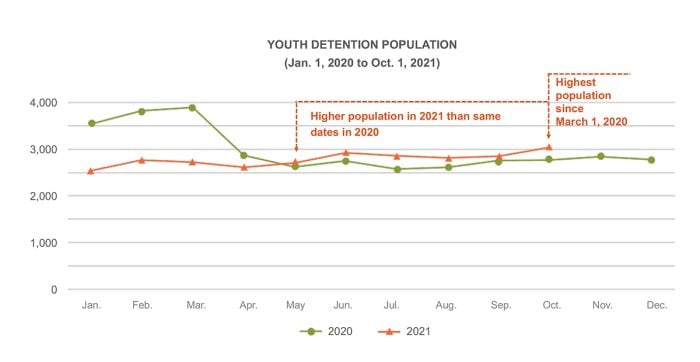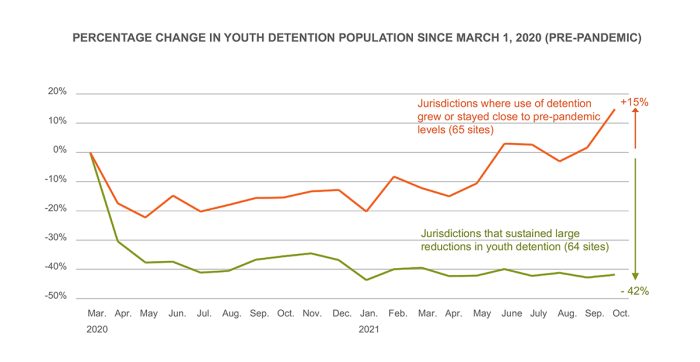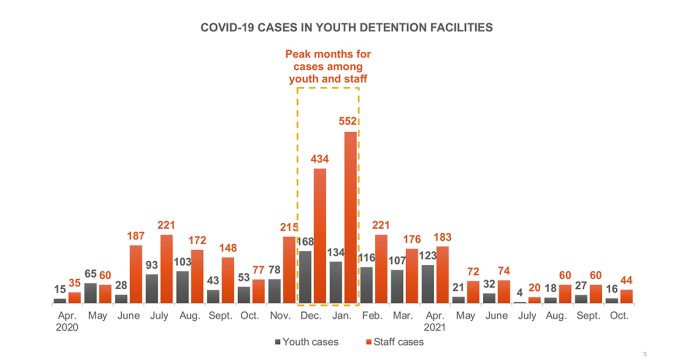Youth Detention Use Reaches Highest Level in 19 Months

The earliest days of the COVID-19 pandemic were marked by a dramatic drop in youth detention. Yet, this trend hasn’t continued, according to a monthly survey of youth justice agencies by the Annie E. Casey Foundation.
The survey — the only large-scale effort of its kind to gauge youth detention populations before and during the pandemic — found that the use of juvenile detention reached a 19-month high on Oct. 1, 2021. Despite this development, the youth detention population is still 22% smaller than it was on March 1, 2020, before the pandemic began.
Black and Latino youth continue to stay longer in detention than their white peers — and even longer than before the pandemic began, according to the latest data, which was pulled on October 1, 2021.
“It’s concerning that the juvenile detention population is the highest it’s been since before the pandemic and that racial disparities have only worsened over the last 18 months,” says Nate Balis, director of the Foundation’s Juvenile Justice Strategy Group. “We know that even a short stay in detention can have profound and potentially lifelong negative consequences for the young people involved.”
The charts below illustrate the survey’s major findings.
The juvenile detention population is still 22% below its pre-pandemic level
The youth detention population remains below its pre-pandemic level. Yet, from May to October 2021, the population count is an average of 7% higher than it was for the same months in 2020 and peaked at 3,043 in October 1, 2021.

Reductions in youth detention were concentrated in half of the jurisdictions
On October 1, 2021, the youth detention population was 22% smaller than pre-pandemic count across the 129 jurisdictions participating in the survey. Half of these jurisdictions (64 total) saw youth detention drop by 42%, with the sharp decrease of 2020 sustained throughout 2021. The remaining jurisdictions (65 total) reported detention jumping 15% from March 1, 2020 to October 1, 2021 — and most of this increase occurred since January 2021. The jurisdictions that reported a shrinking detention population count were generally larger than the sites reporting an uptick.

“Analyzing the national data this way suggests two different worlds — places that have sustained large detention population declines and, unfortunately, places that have seen their early gains erased or even reversed,” says Balis.
Black and Latino youth remain in detention longer than their white peers
The monthly survey collects data broken down by race and ethnicity — a move that offers the juvenile justice field an unprecedented, near-real-time perspective on pandemic-era trends, including disparities.

When the pandemic began in March 2020, juvenile justice systems were quick to de-densify their detention facilities due to public health concerns. Casey’s survey results reflect this reality, with release rates for youth of all races and ethnicities spiking.
Since then, however, releases have slowed, leaving many young people confined and cut off from their families.
Staff are more likely than youth to get COVID-19
The prevalence of COVID-19 among youth and staff in juvenile detention centers has exceeded rates reported in the general population. Active cases among youth in detention peaked in December 2020, survey results indicate. Throughout the pandemic, cases among staff have consistently outpaced cases among youth by more than two to one.

About the survey
The survey, conducted each month since the pandemic began in March 2020, aims to assess the effects of the COVID-19 pandemic on juvenile justice systems around the country. The Foundation captured trends from 129 jurisdictions in 33 states, representing 28% of the nation’s youth population (ages 10–17). For data disaggregated by race and ethnicity, the analysis includes 124 jurisdictions across 32 states, representing 27% of the U.S. youth.
Read more about how the survey is conducted and see previous data releases





